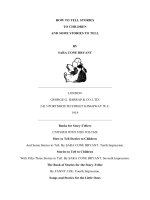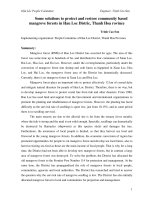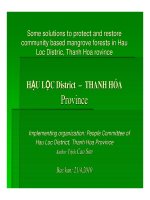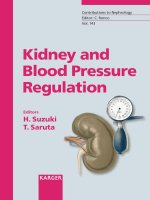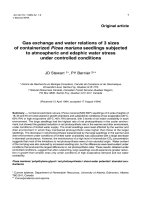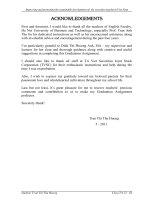Some contributions to maintenance and accelerated degradation test under complex failure process
Bạn đang xem bản rút gọn của tài liệu. Xem và tải ngay bản đầy đủ của tài liệu tại đây (1.34 MB, 200 trang )
SOME CONTRIBUTIONS TO MAINTENANCE AND
ACCELERATED DEGRADATION TEST UNDER COMPLEX
FAILURE PROCESS
CHEN LIANGPENG
(B.Eng.,Tsinghua University)
A THESIS SUBMITTED
FOR THE DEGREE OF DOCTOR OF PHILOSOPHY
DEPARTMENT OF INDUSTRIAL AND SYSTEMS
ENGINEERING
NATIONAL UNIVERSITY OF SINGAPORE
2014
i
Acknowledgements
First and foremost I offer my sincerest gratitude to my main supervisor, Dr.
Boray HUANG, for his guidance, patience, and encouragement throughout
my Ph.D study. Without him, the thesis would not have been possible. I
am also deeply indebted to my co-supervisor, Professor Loon Ching TANG.
His wisdom and experience has illuminated my path to enter the world of
reliability and solve practical problems. I am also grateful to my another
co-supervisor, Professor Min XIE, who always provides timely help and
great care to his students. I also would like to thank Dr. Zhi-Sheng YE,
who offers continuous help, discussion, and encouragement for my research.
My sincere thanks also go to other ISE faculty members and office staff,
who has helped me in one way or another. I am very grateful to my fellow
graduate students in ISE for their friendship and company.
Last but not least, I would like to dedicate this dissertation to my family
- my parents in China and my wife, Guangpu SUN. Your endless love has
always been my strongest motivation to complete this dissertation.
iii
Summary
This thesis investigates several practical issues in maintenance and acceler-
ated degradation testing (ADT), which are two important techniques imple-
mented in the product/system’s life cycle reliability engineering. First off,
the statistical analysis of repairable systems provides useful tools to char-
acterize and predict the system failure behaviour. In view of the widely
observed bathtub type failure rate and intensity during the system lifetime,
we propose a flexible superposed piecewise constant intensity model, which
also takes into consideration the possible substantial changes/shifts due to
rectifications/reliability growth at failures or other time epochs. Next, we
broaden the context to consider repairable production systems, and derive
an optimal bivariate maintenance policy to achieve the cost efficiency. Uti-
lizing the modern monitoring technology, the condition-based maintenance
is facilitated in recent years, we propose a competing risk model to incor-
porate both soft failure due to natural degradation and traumatic failure
due to random shocks. We then analyse the system reliability and obtain
a periodic inspection schedule with degradation-threshold based preventive
maintenance. While maintenance is normally performed when the product
is deployed to the field use, ADT is carried out in design and verification
phase before the mass production. Note that the underlying degradation
of some devices in practice cannot be well described by the existing models
in ADT literature, we propose the implementation of an inverse Gaussian
process. Optimal testing plans are derived to achieve good statistical pre-
cision in estimating the product’s important reliability index, such as the
life percentile. Finally, we pay attention to the practical ADT planning
considering the estimation bias incurred due to the heterogeneity of field
conditions.
Keywords: reliability, life cycle, maintenance, degradation, stochastic pro-
cess, testing.
iv
Contents
Acknowledgements iii
Summary iv
List of Figures viii
List of Tables x
Abbreviations xi
Symbols xii
1 INTRODUCTION 1
1.1 Background . . . . . . . . . . . . . . . . . . . . . . . . . . . 1
1.2 System maintenance modelling and optimization . . . . . . . 4
1.3 Accelerated degradation test . . . . . . . . . . . . . . . . . . 6
1.4 Research objective and structure . . . . . . . . . . . . . . . 8
2 LITERATURE REVIEW 12
2.1 Maintenance modelling and optimization . . . . . . . . . . . 12
2.1.1 Repairable systems . . . . . . . . . . . . . . . . . . . 13
2.1.2 Condition based maintenance . . . . . . . . . . . . . 16
2.2 Accelerated degradation test planning . . . . . . . . . . . . . 19
2.3 Joint maintenance and reliability test . . . . . . . . . . . . . 21
3 A PIECEWISE CONSTANT INTENSITY MODEL AND
RELATED OPTIMAL MAINTENANCE PLANNING 23
3.1 Introduction . . . . . . . . . . . . . . . . . . . . . . . . . . . 23
3.2 Model formulation . . . . . . . . . . . . . . . . . . . . . . . 27
3.3 Statistical inference . . . . . . . . . . . . . . . . . . . . . . . 30
3.3.1 Identical systems . . . . . . . . . . . . . . . . . . . . 30
v
Contents
3.3.2 Non-identical systems . . . . . . . . . . . . . . . . . . 31
3.3.3 Confidence interval . . . . . . . . . . . . . . . . . . . 33
3.3.4 Goodness-of-fit and model selection . . . . . . . . . . 35
3.4 Maintenance planning . . . . . . . . . . . . . . . . . . . . . 37
3.4.1 Event Based Policy . . . . . . . . . . . . . . . . . . . 37
3.4.2 Age Based Policy . . . . . . . . . . . . . . . . . . . . 40
3.5 Numerical example . . . . . . . . . . . . . . . . . . . . . . . 44
3.5.1 The load-haul-dump machine data . . . . . . . . . . 44
3.5.2 The rear dump truck data . . . . . . . . . . . . . . . 49
3.6 Conclusion . . . . . . . . . . . . . . . . . . . . . . . . . . . . 51
4 MAINTENANCE IN AN UNRELIABLE PRODUCTION
SYSTEM WITH IMPERFECT PRODUCTION 52
4.1 Introduction . . . . . . . . . . . . . . . . . . . . . . . . . . . 52
4.2 Model formulation . . . . . . . . . . . . . . . . . . . . . . . 57
4.3 Cost functions and the optimization problem formulation . . 58
4.4 Model analysis and optimality conditions . . . . . . . . . . . 62
4.5 Numerical example . . . . . . . . . . . . . . . . . . . . . . . 64
4.6 Conclusion . . . . . . . . . . . . . . . . . . . . . . . . . . . . 71
5 CONDITION BASED MAINTENANCE FOR SYSTEMS
UNDER DEPENDENT COMPETING FAILURES 72
5.1 Introduction . . . . . . . . . . . . . . . . . . . . . . . . . . . 72
5.2 Assumptions and system reliability analysis . . . . . . . . . 75
5.2.1 Assumptions . . . . . . . . . . . . . . . . . . . . . . . 75
5.2.2 System reliability analysis . . . . . . . . . . . . . . . 77
5.3 Maintenance modelling and optimization . . . . . . . . . . . 78
5.3.1 Maintenance modelling . . . . . . . . . . . . . . . . . 78
5.3.2 Solution procedure . . . . . . . . . . . . . . . . . . . 80
5.4 Numerical example . . . . . . . . . . . . . . . . . . . . . . . 82
5.5 Conclusion . . . . . . . . . . . . . . . . . . . . . . . . . . . . 85
6 ACCELERATED DEGRADATION TEST PLANNING US-
ING THE INVERSE GAUSSIAN PROCESS 86
6.1 Introduction . . . . . . . . . . . . . . . . . . . . . . . . . . . 87
6.2 ADT Planning for the Simple IG process . . . . . . . . . . . 91
6.2.1 The IG process . . . . . . . . . . . . . . . . . . . . . 91
6.2.2 ADT Settings and Assumptions . . . . . . . . . . . . 93
6.2.3 Normalizing the Stress . . . . . . . . . . . . . . . . . 95
6.2.4 Statistical Inference . . . . . . . . . . . . . . . . . . . 95
6.2.5 Optimization Problem . . . . . . . . . . . . . . . . . 98
6.3 ADT Planning for the Random-Effects Model . . . . . . . . 100
vi
Contents
6.3.1 The Random Volatility Model . . . . . . . . . . . . . 100
6.3.2 Assumptions . . . . . . . . . . . . . . . . . . . . . . . 101
6.3.3 Statistical Inference . . . . . . . . . . . . . . . . . . . 102
6.3.4 Optimal ADT planning . . . . . . . . . . . . . . . . . 105
6.4 Numerical example . . . . . . . . . . . . . . . . . . . . . . . 106
6.5 Conclusion . . . . . . . . . . . . . . . . . . . . . . . . . . . . 112
7 ACCELERATED DEGRADATION TEST PLANNING CON-
SIDERING PRODUCT FIELD HETEROGENEITY 114
7.1 Introduction . . . . . . . . . . . . . . . . . . . . . . . . . . . 114
7.2 The model . . . . . . . . . . . . . . . . . . . . . . . . . . . . 117
7.2.1 Degradation in lab test . . . . . . . . . . . . . . . . . 118
7.2.2 Field Degradation with Random Effect . . . . . . . . 119
7.3 Statistical inference . . . . . . . . . . . . . . . . . . . . . . . 122
7.3.1 Field degradation data . . . . . . . . . . . . . . . . . 123
7.3.2 Field life data . . . . . . . . . . . . . . . . . . . . . . 124
7.4 The ADT planning . . . . . . . . . . . . . . . . . . . . . . . 125
7.4.1 The Fraction Failing . . . . . . . . . . . . . . . . . . 126
7.4.2 The p-th life quantile . . . . . . . . . . . . . . . . . . 129
7.5 Numerical example . . . . . . . . . . . . . . . . . . . . . . . 130
7.5.1 Model goodness-of-fit and parameter estimation . . . 130
7.5.2 Optimal ADT planing . . . . . . . . . . . . . . . . . 134
8 CONCLUSION AND FUTURE WORK 136
8.1 Main findings . . . . . . . . . . . . . . . . . . . . . . . . . . 137
8.2 Future research topics . . . . . . . . . . . . . . . . . . . . . 139
A Proofs of Lemma 4.1, Propoition 4.1, 4.2. 141
A.1 Proof of Lemma 4.1: . . . . . . . . . . . . . . . . . . . . . . 141
A.2 Proof of Proposition 4.1: . . . . . . . . . . . . . . . . . . . . 144
A.3 Proof of Proposition 4.2: . . . . . . . . . . . . . . . . . . . . 146
B Derivations of elements in (7.13) and statistical inference
using EM algorithm 147
C Candidate’s publication list arising from the PhD work 152
References 154
vii
List of Figures
1.1 The structure of the thesis. . . . . . . . . . . . . . . . . . . . 11
3.1 Simulated intensity process in various special cases: (a) mono-
tone increasing, (b) monotone decreasing, (c) bathtub type. . 29
3.2 Coverage probability of asymptotic CI procedure with vary-
ing m and n
i
. . . . . . . . . . . . . . . . . . . . . . . . . . . 34
3.3 Residual plot for the LHD machine data. . . . . . . . . . . . 46
3.4 The nonparametric MCF, the parametric PCI model and
PEXP model based on the LHD machine data. . . . . . . . . 46
3.5 Long run average cost versus various maintenance epochs. . 48
3.6 N
∗
and C(N
∗
) versus combinations of c
r
and c
p
. . . . . . . . 49
3.7 The nonparametric MCF, the parametric PCI model and
PEXP model based on the real dump truck data. . . . . . . 50
4.1 AV C with varying T and N . . . . . . . . . . . . . . . . . . 67
4.2 Optimal T and N with varying α. . . . . . . . . . . . . . . . 69
5.1 Plot of reliability function R(t). . . . . . . . . . . . . . . . . 83
5.2 Plot of long-run average maintenance cost rate versus in-
spection interval . . . . . . . . . . . . . . . . . . . . . . . . . 84
6.1 Estimated mean path under each stress level: 65
◦
(left), 85
◦
(middle), 100
◦
(right). The dashed dotted line is based on
direct average of the observed samples, and the solid line is
the estimate based on the IG process. . . . . . . . . . . . . . 109
6.2 χ
2
1
Q-Q plot for the residuals fitted by the simple IG process. 109
6.3 Minimized asymptotic standard deviation versus varying α
0
and λ. . . . . . . . . . . . . . . . . . . . . . . . . . . . . . . 111
7.1 f
T
(t) under different parameter configurations. . . . . . . . . 122
7.2 Simulated degradation paths of carbon film resistors. . . . . 131
7.3 Q-Q plot for the simulated data versus the normal quantile. 132
7.4 Comparison of distribution functions of threshold failure time
under different models. . . . . . . . . . . . . . . . . . . . . . 133
viii
List of Figures
7.5 Q-Q plot fit to the lab data and CDF fit to the field data
using the updated parameters. . . . . . . . . . . . . . . . . . 134
7.6 Contour plot of the asymptotic variance of fraction failings. . 135
ix
List of Tables
3.1 Inter-failure time data for the LHD machine. . . . . . . . . . 45
3.2 95% confidence interval for the parameters and optimal main-
tenance decisions. . . . . . . . . . . . . . . . . . . . . . . . . 48
3.3 Failure time data for the real dump truck. . . . . . . . . . . 49
3.4 Estimated parameters of the PCI and PEXP model in fitting
the rear dump truck data . . . . . . . . . . . . . . . . . . . . 50
4.1 Optimal ({T
i
} , N) and (T, N) policy . . . . . . . . . . . . . 66
4.2 Optimal AV C(T, N) with various (α, β
i
) combinations. . . . 68
4.3 Optimal AV C(T, N) when Z
1
∼Weibull(λ, k). . . . . . . . . 70
4.4 Optimal AV C(T, N) when Z
1
∼Normal(µ, σ). . . . . . . . . 70
4.5 Optimal AV C(T, N) when Z
1
∼Gamma(k, θ). . . . . . . . . 70
5.1 Nelder-Mead algorithm result. . . . . . . . . . . . . . . . . . 83
5.2 Sensitivity analysis of parameters λ, D
f
and α within ±50%
change. . . . . . . . . . . . . . . . . . . . . . . . . . . . . . . 84
6.1 Stress relaxation data under three temperature levels. . . . . 107
6.2 Measurement times under three temperatures. . . . . . . . . 107
6.3 Optimal two level ADT plan using IG process models. . . . . 110
6.4 Optimal ADT plan with varying α
1
for the simple IG process.111
6.5 Optimal ADT plan considering the estimation bias for λ, α
0
and α
1
. . . . . . . . . . . . . . . . . . . . . . . . . . . . . . . 112
x
Abbreviations
PCI Piecewise Constant Intensity
NHPP Non Homogeneous Poisson Process
MLE Maximum Likelihood Estimate
CDF Cumulative Distribution Function
PDF Probability Density Function
LHS Left Hand Side
RHS Right Hand Side
IFR Increasing Failure Rate
EM Expectation Maximization
IG Inverse Gaussian
xi
Symbols
Chapter 3
X
j
Random variable, system’s lifetime be-
tween the j − 1-th and j-th failure,
fix/change
W The length of replacement cycle
C(N/T ) The long run average cost with replace-
ment schedule N/T
c
r
Cost of repair, fix/change
c
p
System replacement cost
α
1
, α
2
, δ
1
, δ
2
Parameters of the PCI model
Θ Parameter space for system replacement
B Bootstrap sample size
Z Random effect
N Number of failures till a system replace-
ment
T Time to replacement
Chapter 4
d demand rate
p production rate
k setup cost per production run
h holding cost per unit per unit time
xii
Symbols
c
r
maintenance cost after system
failure
c
p
maintenance cost before system
failure
c
d
rework cost per defective unit
r cost of each replacement
B random variable,related to the
rate of defective item production
Z
i
time (or age) to breakdown after
the start of the i-th production
run
α parameter of imperfect mainte-
nance effect
AV C({T
i
} , N)/AV C(T, N) expected long run average cost un-
der ({T
i
} , N)/(T, N)policy
CL({T
i
} , N )/CL(T, N) expected cycle length under
({T
i
} , N )/(T, N)policy
DE({T
i
} , N)/DE(T, N) expected total rework cost of de-
fective units in a production cycle
under ({T
i
} , N )/(T, N)policy
HC({T
i
} , N )/HC(T, N) expected maintenance cost
in a production cycle under
({T
i
} , N )/(T, N)policy
SC({T
i
} , N )/SC(T, N) total production setup cost
in a production cycle under
({T
i
} , N )/(T, N)policy
T C({T
i
} , N )/T C(T, N) total expected cost in a
production cycle under
({T
i
} , N )/(T, N)policy
xiii
Symbols
T
i
/T time to perform maintenance after
the start of i-th production run.
In the case of (T, N) policy,T
i
=
T, i = 1, 2, , N .
N number of production runs per
production cycle
Chapter 6
Y (t) product degradation path
T
D
product lifetime
D failure critical level
IG(a, b) the inverse Gaussian distribution
θ
l
parameter space of model l
ρ
q
product failure quantile
N sample size
P number of stress levels
m measurement times
τ measurement frequency
I(θ
l
) Fisher information matrix under parameter space θ
l
ψ(·) digamma function
Φ(·) standard normal CDF
φ(·) standard normal PDF
s
i
, i = 1, · · · , P stress levels
n
i
, i = 1, · · · , P number of units allocated to s
i
Chapter 7
Y (t) product degradation path
T product lifetime
D failure critical level
g(ξ, η) inthe Gamma distribution with shape pa-
rameter η and scale parameter ξ
θ parameter space
xiv
Symbols
θ
1
, θ
2
parameter of the actual acceleration relationship
a, b parameter of the transformed acceleration relationship
µ
s
, σ
s
distribution parameter of the actual stress level
µ
s
, σ
s
distribution parameter of the transformed stress level
µ
ξ
, σ
ξ
indistribution parameter of the acceleration
relationship with Gamma process
γ(s, x) lower incomplete Gamma function
t
w
warranty length
s
actual stress level
s transformed stress level
c
0
warranty cost per repair
N
wi
, i = 1, 2 expected number of warranty repairs for two policies
E(C
wi
), i = 1, 2 expected warranty cost for two policies
N test sample size
P number of stress levels
m measurement times
t measurement frequency
I(θ) Fisher information matrix
ψ(·) digamma function
ψ
1
(·) trigamma function
xv
Chapter 1
INTRODUCTION
1.1 Background
Facing the intensive competition and customers’ expectation, manufactur-
ers today are under great pressures to improve the product’s reliability
during its life cycle. For example, in the design and development phase,
maximum reliability needs to be built into the product. To verify the suc-
cess of a completed design, a small number of prototypes are collected and
tested in the verification and validation phase. Once a product is deployed
into the field, a warranty usually accompanies with the product in which
appropriate maintenance operations are performed to mitigate the product
degradation and consequent failures in the field operation. On the contrary,
ignoring degradation and failures results in significant loss. For example,
1
Chapter 1. Introduction
Attardi et al. (2005) shows that the lack of reliability tests prior to product
delivery will incur a substantial amount of failures in the automobile indus-
try. In the electrical industry in US, there is 150 billion in economic losses
due to outages related to reliability issues (Rouse and Kelly, 2011). To this
end, many reliability techniques are involved and inherently related in the
above phases, such as failure mode and effect analysis (FMEA), accelerated
test, maintenance and warranty analysis, etc.
This thesis investigates maintenance and accelerated degradation tests (ADT)
under complex failure processes. In reliability theory, the lifetime distri-
bution model is adopted by most of the literature, due to the tradition
and convenience, as well as its description for items’ ageing characteristics
and fitness to the data. However, the ageing nature of the lifetime model
restricts its capability of interpreting either more essential or complicated
situations encountered in recent research and practice. Some of these situ-
ations are summarized as follows:
• The reliability requirement for products is increasingly high to meet a
sequence of specified performances. For example, an electronic prod-
uct may be viewed as a complex system that consists of many compo-
nents. To maintain high reliability for the entire system, it generally
requires that the individual components have extremely high reliabil-
ity (Lu and Meeker, 1993). Therefore, censored data may be collected
2
Chapter 1. Introduction
with very few failures. Consequently, it is generally difficult to im-
plement the lifetime model for inference.
• Products possess their own specific failure-generating mechanisms,
many of which can be traced to an underlying degradation process.
The unique failure mechanism, however, is unable to be captured by
the lifetime model. On the contrary, a degradation model based on
the product’s physics, if appropriately chosen and readily observed by
modern monitoring technology, will be more timely and informative
(Meeker et al., 1998).
• At the system level, especially for repairable systems, component fail-
ures usually result in minor rectifications of the system, and system
may experience a series of failures before it is completely overhauled.
Typically, it is inadequate to use the lifetime model to characterize
the system failure behaviour (recurrent events) during its lifetime.
To some extent, the above difficulties encountered can be readily resolved
by using stochastic process models. Stochastic processes emerge as a new
class of failure models (Singpurwalla, 1995) and receive increasing attention
in various areas of reliability engineering. In the following, we briefly in-
troduce the implementation of stochastic process models in the framework
of both maintenance and accelerated degradation tests. Issues of current
3
Chapter 1. Introduction
research are also addressed, based on which the motivations of this thesis
are highlighted.
1.2 System maintenance modelling and op-
timization
System maintenance is very common in practice. Usually the system is re-
pairable, meaning that when failing to perform its functions satisfactorily,
it can be restored to fully satisfactory performance by some method other
than replacement of the entire system. Consequently, recurrent events of
failures/rectifications are observed during system lifetime. As these events
occur randomly and inherently related to each other on some level, stochas-
tic processes appear suitable models to characterize the failure process and
determine future maintenance actions. Various models are proposed to ac-
commodate different types of systems as well as their failure time data. For
example, the renewal process, where the system is as good as new after a
repair, and non-homogeneous Poisson process (NHPP), where the system
always receives a minimal repair at failures, are two widely-used models.
Statistical analysis of failure data and maintenance planning can be found
in several studies, such as Jaturonnatee et al. (2006), Lawless et al. (2012),
Pulcini (2014) and Rigdon and Basu (2000), to name a view.
4
Chapter 1. Introduction
Another class of models implement the stochastic process models to depict
the underlying process of system degradation toward failures. As a result,
maintenance is then performed to alleviate the degradation and prevent
failures. Usually system degradation signals in one way or another, which
can be measured directly or indirectly. With the advance of modern mea-
surement technology and sensors, the monitoring of system real-time health
becomes feasible within an increasing number of areas. For instance, the
health condition of helicopter drive train system can be monitored by col-
lecting the vibration signals from the hanger bearings, testing the electrical
insulation degradation serves as a diagnostic tool of electric motor’s health
condition. With the degradation information on hand, stochastic process
models are commonly chosen to characterize system degradation due to
their flexibility to account for the correlation of time-dependent degrada-
tion measurement. More precise estimates of system reliability and better
maintenance planning are then obtained. Optimal maintenance policies
under different stochastic degradation models have been discussed by Liao
et al. (2006), Dieulle et al. (2003a), Ye et al. (2012), Si et al. (2014), etc.
An overview of the application of gamma process in maintenance can be
found in Van Noortwijk (2009).
Although many models have been proposed on maintenance using stochas-
tic process approach, a number of deficiencies still exist. First, for modelling
the failure process of repairable systems, most of the existing models only
5
Chapter 1. Introduction
describe either reliability improvement or reliability degradation, notwith-
standing the fact of the well-known bathtub type failure intensity. In addi-
tion, possible substantial changes at failures, leading to reliability growth
in practice, are seldom considered. Last but not least, most models assume
single failure mode while this failure mode is subject to the degradation
of system exceeding certain critical threshold. Nevertheless, most systems
can fail due to a variety of failure modes or competing risks. Therefore, an
integrated framework is desired for characterizing their joint effects.
1.3 Accelerated degradation test
An important program initiated in practice to obtain the reliability metric
of developed products is to perform the tests in the earlier stage. It is
extensively conducted in both design and production phases on materials,
components and systems. However, the time duration allowed for testing
is usually much shorter than the expected operating lives of products. In
line with the modern quality philosophy for producing high-reliability prod-
ucts, most of products are designed to operate without failures for years,
decades, or longer. Therefore, testing under normal use condition is costly
and unrealistic. Accelerated tests are hence motivated to obtain timely
information in which test units are exposed to harsh conditions. Degra-
dation is accelerated and more failures occur. Reliability estimates under
6
Chapter 1. Introduction
normal use level can be obtained by extrapolation from high level through
some physically meaningful statistical model that links the stress with unit
reliability.
In some cases, failures of sample units are rather frequently observed dur-
ing test. However, for highly reliable products, failures seldom occur even
under elevated stresses. To overcome this situation, degradation tests are
facilitated, which measure some characteristic of interest in testing units.
This characteristic represents unit’s degradation gradually, and failure oc-
curs when the degradation is not acceptable, i.e., exceeds some threshold.
For example, the carbon film resistors may exhibit a shift on the resis-
tance and fail when the shift is too large. In accelerated degradation test,
stochastic processes are widely employed to model unit’s degradation. For
example, Wiener process and gamma process models are implemented in
various ADT studies (Tang et al., 2004; Tseng et al., 2009; Lim and Yum,
2011).
Despite the wide applications of wiener process and gamma process mod-
els, there are circumstances where neither of the two models is appropriate.
Some complementation to the family of degradation models are essential,
and their applications in ADT need to be explored. For example, as a lim-
iting process of the compound Poisson process, the inverse Gaussian pro-
cesses are physically suitable to characterize the gradual growth of degra-
dation, such as wear, crack, etc. Therefore, it is important to invoke the
7
Chapter 1. Introduction
inverse Gaussian process for ADT study when it describes the degradation
data well. Moreover, the objective of current ADT plans are focused on
the life quantiles. Other objectives of practical importance should also be
investigated, such as the fraction failings within a warranty period which
is directly related to the field return of products, and the total warranty
cost. Besides, the product’s operating condition in the field is heteroge-
neous, such as the usage rate of products varies for different customers, the
operating environment is different, etc. This may bias the estimation and
thus should be considered if possible.
1.4 Research objective and structure
As indicated in the above comprehensive review, the gaps of current re-
search in maintenance and accelerated degradation test under complex pro-
cesses can be summarized as follows:
• The characterization of failure process of repairable systems usually
implement the stochastic point processes where the failure intensity
is naturally denoted by the arrival rate. However, the existing mod-
els depict either monotone increasing or decreasing failure intensity,
ignoring the commonly observed bathtub type. Moreover, the conti-
nuity of point process implicitly assumes minimal repair or renewal
of system whenever failure occurs, which is unable to account for
8
Chapter 1. Introduction
maintenance degree in between or substantial changes (e.g. reliabil-
ity growth) at failures or other time epochs.
• Stochastic process are widely used to describe system/component
degradation. Complex systems usually fail due to a variety of sources.
Few studies address the maintenance of degraded systems subject to
multiple failure modes.
• The selection of an appropriate candidate model is the essential step
in planning the accelerated degradation tests. Models include lin-
ear degradation path and stochastic processes are both advocated.
Within the stochastic process category, only weiner process and gamma
process are used, and it is found that some dataset of products in
practice are not adequately fitted by these two models. Therefore,
the accelerated degradation test of these products may be planned
based on a new stochastic process.
• The objective of current research on ADT is focused on the product
life quantile or D-optimality. However, since the main objective of
ADT is to predict the product reliability in the field, the heteroge-
neous field condition needs to be considered.
This thesis intends to propose some practical models to resolve the above
problems. Specifically, the objectives of this research are to:
9

